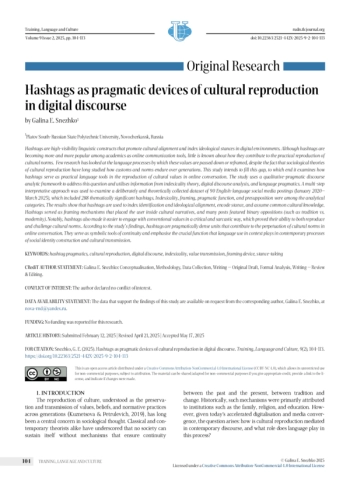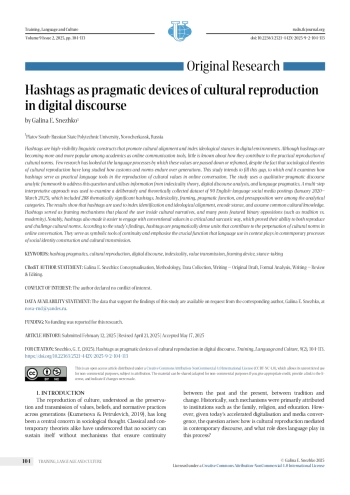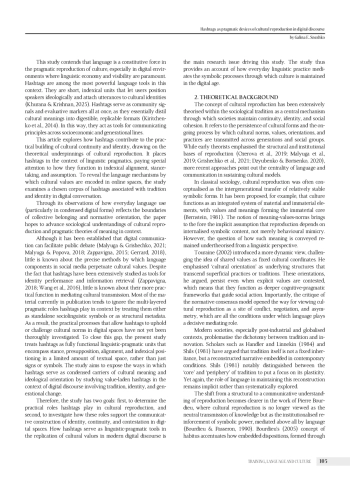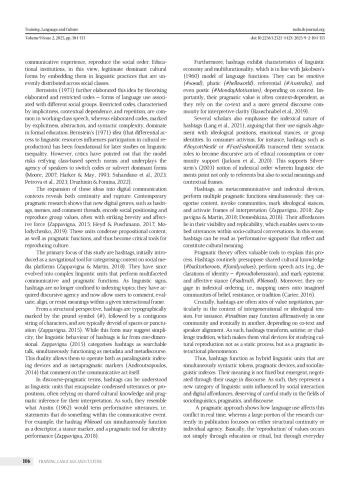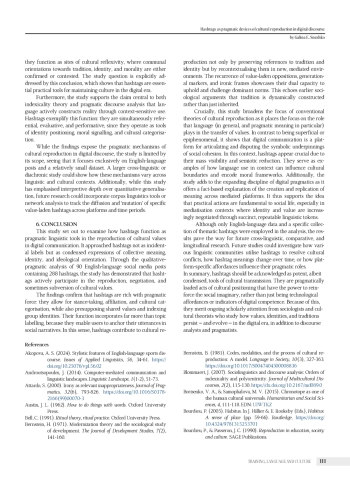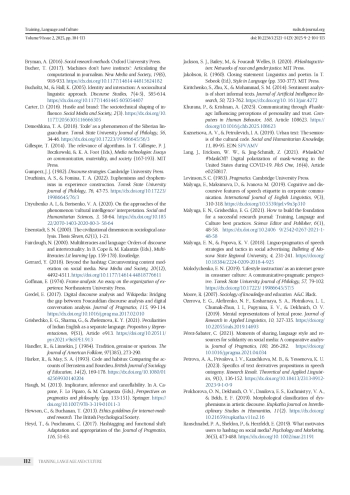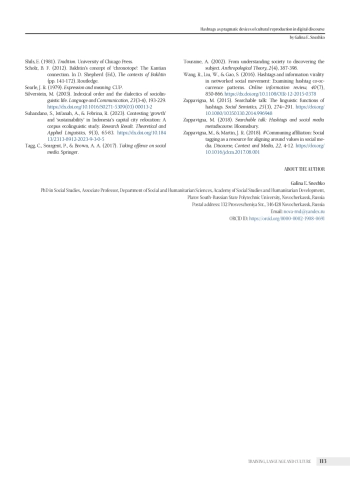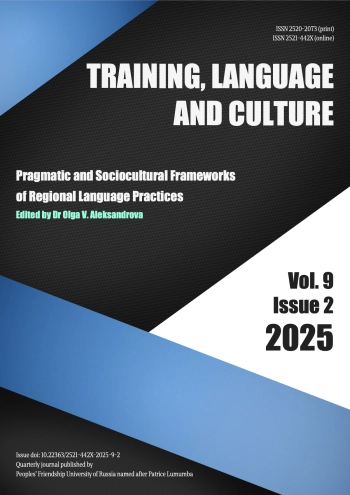Hashtags are high-visibility linguistic constructs that promote cultural alignment and index ideological stances in digital environments. Although hashtags are becoming more and more popular among academics as online communication tools, little is known about how they contribute to the practical reproduction of cultural norms. Few research has looked at the language processes by which these values are passed down or reframed, despite the fact that sociological theories of cultural reproduction have long studied how customs and norms endure over generations. This study intends to fill this gap, to which end it examines how hashtags serve as practical language tools in the reproduction of cultural values in online conversation. The study uses a qualitative-pragmatic discourse analytic framework to address this question and utilises information from indexicality theory, digital discourse analysis, and language pragmatics. A multi-step interpretative approach was used to examine a deliberately and theoretically collected dataset of 90 English-language social media postings (January 2020– March 2025), which included 288 thematically significant hashtags. Indexicality, framing, pragmatic function, and presupposition were among the analytical categories. The results show that hashtags are used to index identification and ideological alignment, encode stance, and assume common cultural knowledge. Hashtags served as framing mechanisms that placed the user inside cultural narratives, and many posts featured binary oppositions (such as tradition vs. modernity). Notably, hashtags also made it easier to engage with conventional values in a critical and sarcastic way, which proved their ability to both reproduce and challenge cultural norms. According to the study’s findings, hashtags are pragmatically dense units that contribute to the perpetuation of cultural norms in online conversation. They serve as symbolic tools of continuity and emphasise the crucial function that language use in context plays in contemporary processes of social identity construction and cultural transmission.
Идентификаторы и классификаторы
The reproduction of culture, understood as the preservation and transmission of values, beliefs, and normative practices across generations (Kuznetsova & Petrulevich, 2019), has long been a central concern in sociological thought. Classical and contemporary theorists alike have underscored that no society can sustain itself without mechanisms that ensure continuity between the past and the present, between tradition and change. Historically, such mechanisms were primarily attributed to institutions such as the family, religion, and education. However, given today’s accelerated digitalisation and media convergence, the question arises: how is cultural reproduction mediated in contemporary discourse, and what role does language play in this process?
Список литературы
1. Akopova, A. S. (2024). Stylistic features of English-language sports discourse. Issues of Applied Linguistics, 56, 34-61. DOI: 10.25076/vpl.56.02
2. Androutsopoulos, J. (2014). Computer-mediated communication and linguistic landscapes. Linguistic Landscape, 1(1-2), 51-73.
3. Attardo, S. (2000). Irony as relevant inappropriateness. Journal of Pragmatics, 32(6), 793-826. DOI: 10.1016/S0378-2166(99)00070-3 EDN: AFMSUJ
4. Austin, J. L. (1962). How to do things with words. Oxford University Press.
5. Bell, C. (1991). Ritual theory, ritual practice. Oxford University Press.
6. Bernstein, H. (1971). Modernization theory and the sociological study of development. The Journal of Development Studies, 7(2), 141-160.
7. Bernstein, B. (1981). Codes, modalities, and the process of cultural reproduction: A model. Language in Society, 10(3), 327-363. DOI: 10.1017/S0047404500008836
8. Blommaert, J. (2007). Sociolinguistics and discourse analysis: Orders of indexicality and polycentricity. Journal of Multicultural Discourses, 2(2), 115-130. DOI: 10.2167/md089.0
9. Borisenko, V. A., & Samophalova, M. V. (2015). Chronotope as one of the human cultural universals. Humanitarian and Social Sciences, 4, 111-118. EDN: UIWTKZ
10. Bourdieu, P. (2005). Habitus. In J. Hillier & E. Rooksby (Eds.), Habitus: A sense of place (pp. 59-66). Routledge. DOI: 10.4324/9781315253701
11. Bourdieu, P., & Passeron, J. C. (1990). Reproduction in education, society and culture. SAGE Publications.
12. Bryman, A. (2016). Social research methods. Oxford University Press.
13. Bucher, T. (2017). ‘Machines don’t have instincts’: Articulating the computational in journalism. New Media and Society, 19(6), 918-933. DOI: 10.1177/1461444815624182
14. Bucholtz, M., & Hall, K. (2005). Identity and interaction: A sociocultural linguistic approach. Discourse Studies, 7(4-5), 585-614. DOI: 10.1177/1461445605054407
15. Carter, D. (2016). Hustle and brand: The sociotechnical shaping of influence. Social Media and Society, 2(3). DOI: 10.1177/2056305116666305
16. Demeshkina, T. A. (2018). ‘Exile’ as a phenomenon of the Siberian linguaculture. Tomsk State University Journal of Philology, 56, 34-46. DOI: 10.17223/19986645/56/3
17. Gillespie, T. (2014). The relevance of algorithms. In T. Gillespie, P. J. Boczkowski, & K. A. Foot (Eds.), Media technologies: Essays on communication, materiality, and society (167-193). MIT Press.
18. Gumperz, J. J. (1982). Discourse strategies. Cambridge University Press.
19. Druzhinin, A. S., & Fomina, T. A. (2022). Euphemisms and dysphemisms in experience construction. Tomsk State University Journal of Philology, 76, 47-75. DOI: 10.17223/19986645/76/3
20. Dzyubenko A. I., & Borisenko, V. A. (2020). On the approaches of the phenomenon ‘cultural intelligence’ interpretation. Social and Humanitarian Sciences, 3, 58-64. DOI: 10.18522/2070-1403-2020-80-3-58-64
21. Eisenstadt, S. N. (2000). The civilizational dimension in sociological analysis. Thesis Sleven, 62(1), 1-21.
22. Fairclough, N. (2000). Multiliteracies and language: Orders of discourse and intertextuality. In B. Cope & M. Kalantzis (Eds.), Multiliteracies: Lit learning (pp. 159-178). Routledge. DOI: 10.4324/9780203979402
23. Gerrard, Y. (2018). Beyond the hashtag: Circumventing content moderation on social media. New Media and Society, 20(12), 4492-4511. DOI: 10.1177/1461444818776611
24. Goffman, E. (1974). Frame analysis: An essay on the organization of experience. Northeastern University Press.
25. Gredel, E. (2017). Digital discourse analysis and Wikipedia: Bridging the gap between Foucauldian discourse analysis and digital conversation analysis. Journal of Pragmatics, 115, 99-114. DOI: 10.1016/j.pragma.2017.02.010
26. Grishechko, E. G., Sharma, G., & Zheleznova, K. Y. (2021). Peculiarities of Indian English as a separate language. Propositos y Representaciones, 9(S1), Article e913. DOI: 10.20511/pyr2021.v9nSPE1.913
27. Handler, R., & Linnekin, J. (1984). Tradition, genuine or spurious. The Journal of American Folklore, 97(385), 273-290.
28. Harker, R., & May, S. A. (1993). Code and habitus: Comparing the accounts of Bernstein and Bourdieu. British Journal of Sociology of Education, 14(2), 169-178. DOI: 10.1080/0142569930140204
29. Haugh, M. (2013). Implicature, inference and cancellability. In A. Capone, F. Lo Piparo, & M. Carapezza (Eds.), Perspectives on pragmatics and philosophy (pp. 133-151). Springer. DOI: 10.1007/978-3-319-01011-3
30. Hewson, C., & Buchanan, T. (2013). Ethics guidelines for internet-mediated research. The British Psychological Society.
31. Heyd, T., & Puschmann, C. (2017). Hashtagging and functional shift: Adaptation and appropriation of the. Journal of Pragmatics, 116, 51-63. DOI: 10.1016/j.pragma.2016.12.004
32. Jackson, S. J., Bailey, M., & Foucault Welles, B. (2020). Hashtagactivism: Networks of race and gender justice. MIT Press.
33. Jakobson, R. (1960). Closing statement: Linguistics and poetics. In T. Sebeok (Ed.), Style in Language (pp. 350-377). MIT Press.
34. Kiritchenko, S., Zhu, X., & Mohammad, S. M. (2014). Sentiment analysis of short informal texts. Journal of Artificial Intelligence Research, 50, 723-762. DOI: 10.1613/jair.4272
35. Khurana, P., & Krishnan, A. (2025). Communicating through hashtags: Influencing perceptions of personality and trust. Computers in Human Behavior, 168, Article 108623. DOI: 10.1016/j.chb.2025.108623
36. Kuznetsova, A. V., & Petrulevich, I. A. (2019). Urban text: The semiosis of the cultural code. Social and Humanitarian Knowledge, 11, 89-95. EDN: SPVAMV
37. Lang, J., Erickson, W. W., & Jing-Schmidt, Z. (2021). MaskOn! MaskOff! Digital polarization of mask-wearing in the United States during COVID-19. PloS One, 16(4), Article e0250817. DOI: 10.1371/journal.pone.0250817
38. Levinson, S. C. (1983). Pragmatics. Cambridge University Press.
39. Malyuga, E., Maksimova, D., & Ivanova M. (2019). Cognitive and discoursive features of speech etiquette in corporate communication. International Journal of English Linguistics, 9(3), 310-318. DOI: 10.5539/ijel.v9n3p310 EDN: EMSWGI
40. Malyuga, E. N., Grishechko, E. G. (2021). How to build the foundation for a successful research journal: Training, Language and Culture best practices. Science Editor and Publisher, 6(1), 48-58. DOI: 10.24069/2542-0267-2021-1-48-58
41. Malyuga, E. N., & Popova, K. V. (2018). Linguo-pragmatics of speech strategies and tactics in social advertising. Bulleting of Moscow State Regional University, 4, 231-241. DOI: 10.18384/2224-0209-2018-4-925 EDN: YSQCWT
42. Molodychenko, E. N. (2019). ‘Lifestyle instruction’ as an internet genre in consumer culture: A communicative-pragmatic perspective. Tomsk State University Journal of Philology, 57, 79-102. DOI: 10.17223/19986645/57/5
43. Moore, R. (2007). Sociology of knowledge and education. A&C Black.
44. Ozerova, E. G., Alefirenko, N. F., Kosharnaya, S. A., Plotnikova, L. I., Chumak-Zhun, I. I., Pupynina, E. V., & Dekhnich, O. V. (2019). Mental representations of lyrical prose. Journal of Research in Applied Linguistics, 10, 327-335. DOI: 10.22055/rals.2019.14693 EDN: YPWYYM
45. Pérez-Sabater, C. (2021). Moments of sharing, language style and resources for solidarity on social media: A comparative analysis. Journal of Pragmatics, 180, 266-282. DOI: 10.1016/j.pragma.2021.04.034 EDN: LFXFPR
46. Petrova, A. A., Privalova, I. V., Kazachkova, M. B., & Yessenova, K. U. (2023). Specifics of text derivatives propositions in speech ontogeny. Research Result. Theoretical and Applied Linguistics, 9(1), 136-152. DOI: 10.18413/2313-8912-2023-9-1-0-9
47. Prokhorova, O. N., Dekhnich, O. V., Danilova, E. S., Kuchmistyy, V. A., & Bekh, E. F. (2019). Morphological classification of dysphemisms in artistic discourse. Rupkatha Journal on Interdisciplinary Studies in Humanities, 11(2). DOI: 10.21659/rupkatha.v11n2.16 EDN: NSQVVZ
48. Rauschnabel, P. A., Sheldon, P., & Herzfeldt, E. (2019). What motivates users to hashtag on social media? Psychology and Marketing, 36(5), 473-488. DOI: 10.1002/mar.21191
49. Shils, E. (1981). Tradition. University of Chicago Press.
50. Scholz, B. F. (2012). Bakhtin’s concept of ‘chronotope’: The Kantian connection. In D. Shepherd (Ed.), The contexts of Bakhtin (pp. 141-172). Routledge. DOI: 10.4324/9780203059692
51. Searle, J. R. (1979). Expression and meaning: Studies in the theory of speech acts. Cambridge University Press.
52. Silverstein, M. (2003). Indexical order and the dialectics of sociolinguistic life. Language and Communication, 23(3-4), 193-229. DOI: 10.1016/S0271-5309(03)00013-2 EDN: BJHPKH
53. Suhandano, S., Isti’anah, A., & Febrina, R. (2023). Contesting ‘growth’ and ‘sustainability’ in Indonesia’s capital city relocation: A corpus ecolinguistic study. Research Result. Theoretical and Applied Linguistics, 9(3), 65-83. DOI: 10.18413/2313-8912-2023-9-3-0-5
54. Tagg, C., Seargent, P., & Brown, A. A. (2017). Taking offence on social media. Springer. DOI: 10.1007/978-3-319-56717-4
55. Touraine, A. (2002). From understanding society to discovering the subject. Anthropological Theory, 2(4), 387-398.
56. Wang, R., Liu, W., & Gao, S. (2016). Hashtags and information virality in networked social movement: Examining hashtag co-occurrence patterns. Online information review, 40(7), 850-866. DOI: 10.1108/OIR-12-2015-0378
57. Zappavigna, M. (2015). Searchable talk: The linguistic functions of hashtags. Social Semiotics, 25(3), 274-291. DOI: 10.1080/10350330.2014.996948
58. Zappavigna, M. (2018). Searchable talk: Hashtags and social media metadiscourse. Bloomsbury.
59. Zappavigna, M., & Martin, J. R. (2018). Communing affiliation: Social tagging as a resource for aligning around values in social media. Discourse, Context and Media, 22, 4-12. DOI: 10.1016/j.dcm.2017.08.001
Выпуск
Другие статьи выпуска
The Elgar Encyclopaedia of Cross-Cultural Management is a series of chapters written by academic experts on the study of culture in world business management. Edited by Professor Audra Mockaitis of Maynooth University in Ireland and Professor Christina Butler of Kingston Business School in Kingston University in the UK, the articles are written by seventy-eight university teachers from all over the world examining international business cultural management issues. The book contains 77 chapters, some as short as two pages long, and examines the role of cultural understanding in international business management, each chapter containing references to sources at the end.
Autonyms, a blend of auto- (car) and -nyms (names), constitute a subclass of ergonyms (object names) and a subdomain of onomastics I am prone to term ‘autonomastics’, a subdivision which is still understudied rather unstudied. No past research has investigated autonyms as novel tradenames dealers and purchasers assign to cars in automotive transactions. The onomastic facets of autonyms have received no attention from specialist linguists across or within world languages. This article aims to conduct a seminal lexical-semiotic analysis of ‘autonyms’ (car names). A lexicosemiotic analysis of autonyms in Egyptian Arabic is conducted by analysing their lexical and semiotic aspects with particular focus on onomastic and sign-based classifications. The article undertakes a typological analysis of a convenience sample of a dataset extracted from three e-platforms (Dubizzle, Youm7, and Masrawy) and validated through an interrater reliability questionnaire. The analysis draws mainly on a comprehensive but non-exhaustive state-of-the-art typology of denominata and denominating practices. Results show that car trademarks are transacted on the local Egyptian market under culture-specific tradenames which establish iconic, indexical, and symbolic relations between the representamens and their objects. The tradenames cover a myriad of autonyms denoting animals (zoonyms), insects (entomonyms), reptiles (herpetonyms), fish (ichthyonyms), birds (ornithonyms), and objects (ergonyms). It shows the role of Egyptian Arabic vernacular in communicating collective cognition of naming practices in the Egyptian automotive community. The article recommends replicating the devised typology with crosslinguistic and cross-cultural datasets to inform future research into onomastics in general and autonomastics in particular and probably inspire automobile industries to redesign their cars accordingly.
With the rise of streaming platforms like Netflix, viewers now have greater access to language and accessibility features. Audio description (AD) translates visual information into spoken language, enabling access for viewers with visual impairments. To match the experience of sighted audiences, AD must convey all visual cues, including physical appearances. Despite its importance, this area – where accessibility and inclusivity intersect – remains understudied. This paper investigates how Netflix’s AD represents different body types, physiques, and visible disabilities among able-bodied and disabled individuals. Using a qualitative descriptive approach, the study analyses AD in two series, one film, and one documentary to assess clarity, accuracy, consistency, and implications of these descriptions. Findings reveal inconsistencies in describing body shape and size, with such references being rare and often contingent on plot relevance. Descriptions typically appear in contexts tied to body image or physical performance, especially relating to athleticism and (dis)ability. In cases involving disability, AD often describes mobility aids rather than the individuals themselves – an approach that avoids potentially offensive terms but risks reinforcing the taboo around discussing disability. The study suggests that these inconsistencies stem from both linguistic limitations and a reliance on perceived relevance. It concludes that prevailing discourse and stigma around describing human bodies complicate AD practices. Further research is needed to refine AD guidelines, ensuring they reflect the perspectives of both those being described and those who rely on AD.
This study investigates the translation of shared culture-bound expressions in the English version of the Arabic novel The Yacoubian Building and its subtitled film adaptation. A total of 50 expressions found in both the written text (RT) and the cinematic text (CT) are identified and classified into four thematic categories: swearing, idiomatic/proverbial, religious, and address expressions. The analysis examines the use of three translation strategies across these genres: cultural substitution, paraphrase, and literal translation. Cultural substitution is the most frequently used strategy overall and is consistently applied across both genres (RT 32% and CT 30%) and across thematic categories. Literal translation is more frequent in the RT (20%) than in the CT (14%), indicating a greater tolerance for cultural retention in written discourse. Paraphrase, by contrast, is employed more often in the CT (44%) than in the RT (22%), reflecting its practicality in subtitling, where spatial and temporal constraints limit the use of literal or culturally anchored renderings. The findings also reveal that swearing and religious expressions are most often translated using cultural substitution due to their cross-culturally familiar nature, while idiomatic and proverbial expressions are primarily paraphrased because of their deeply embedded linguistic and cultural features. While the translations in both genres are largely successful in conveying meaning, the study recommends expanding the use of cultural substitution in audiovisual contexts to maintain viewer engagement and preserve discursive impact.
This study investigates the sociolinguistic functions of kinship terms within the Marwari speech community of Rajasthan, addressing the gap in research concerning how language structures reflect and reinforce familial and social identity. The primary aim is to explore the cultural context in which kinship terminologies are used, focusing on how these terms encode generational, hierarchical, and gendered relationships. Employing a communication ethnographic framework, the study uses participant and non-participant observation, questionnaires, semi-structured interviews, and genealogical diagrams to collect and analyse data from five native Marwari speakers. Findings reveal that Marwari kinship terms are distinctly categorised into consanguineal (blood) and affinal (marital) relations, with both core and peripheral subcategories. The terms incorporate honorifics such as /sa/ and /ɟi/ and reflect gender differentiation through suffixes like /i/ and /ni/. The structure and use of these terms not only establish familial connections but also underscore respect, social cohesion, and the deeply embedded cultural values of the Marwari community. The implications of this study are both theoretical and practical: it contributes to the understanding of how linguistic practices mediate social relationships and identity in traditional communities, highlights the cultural significance of kinship lexicons in language maintenance, and underscores the importance of preserving linguistic diversity in the face of increasing language contact and shift.
This study was motivated by the initial observations of Jordanian people’s distinct use of live (novel) and dead (conventional) linguistic metaphors when they narrate their different sad and happy experiences in natural contexts in Jordan. While there has been sufficient research into metaphor from a cognitivediscursive perspective, there has been a lack of metaphor research that links cognitive analysis with practice. The present study aims to examine if live and dead metaphors correlate with speaker’s types of experiences and find their practical implications. In this study, participants were selected using the convenience sampling strategy. The collected metaphorical expressions from participants went through four analysis stages: transcription, manual identification of metaphorical expressions, inductive coding and interpretation. The present study uses discourse analysis to enrich the practice approach (e. g., effective (in)formal communication). This paper found that people narrating their sad experiences rely on live metaphors more than dead metaphors. This can be attributed to two reasons. Live metaphors serve as rhetorical devices that can attract the addressee’s attention and facilitate articulating sensitive issues more effectively than conventional or dead metaphors. This study thus suggests that live metaphors have a more effective role than dead metaphors in various modes of professional communication such as psychological counselling, politics and debates. This distinction, as revealed by the data analysis, can bear important implications that are worth considering in various fields. Thus, this study recommends communication and rhetoric researchers to investigate how live metaphors can strategically be employed in such modes of communication in various cultures.
This study focuses on the development of an algorithm for constructing the vocabulary of a Syrian dialectal multimedia dictionary. The significance of this research stems from the inadequate representation of Syrian dialectal lexicon in existing lexicographical resources. The novelty lies in the creation of a universal model for an Arabic dialectal multimedia dictionary, using the Syrian dialect as a foundation, and in proposing a methodology for utilising film texts as a source of Arabic dialectal vocabulary, followed by the processing of this lexical material. The initial sample of dialectal lexical items comprised 100 words and was subsequently expanded to 1,500. The proposed multimedia dictionary project caters to the needs of diverse user categories by providing, for example, etymological, phonetic, grammatical, and semantic information about each lexical unit, visualisation of its concept, and supplementary semantisation through film discourse fragments. Encompassing both original Arabic words and borrowings from languages such as Syriac, Turkish, French, and English, the dictionary aims to reflect the lexical composition of the Syrian dialect and is geared towards enhancing the systematisation and lexicography of Arabic dialects in general. This endeavour makes a substantial contribution to the fields of linguistics and lexicography, while also promoting the preservation and study of Arabic dialects.
The use of address forms varies from culture to culture according to each society’s sociocultural values and norms. Therefore, the variations in the choice, usage, and understanding of forms of address can create communication problems. This study investigates address forms used in Algerian society between nonacquaintances in different age and gender contexts. It aims to identify the main address categories used to address a stranger and to trace the impact of sociocultural norms and values on their preferences. For this purpose, a discourse-completion task (DCT) was used to collect data from 104 Algerian respondents of different ages and genders which were analysed quantitatively and qualitatively. The results show that Algerians use a variety of address forms with kinship terms dominating, followed by religious terms. They testify that politeness in Algerian society is established by showing deference and respect to elders and at the same time demonstrating intimacy and closeness to the addressee, which is prescribed by the Qur’an. However, the choice of a term is determined by age, power, gender and distance. The findings reflect the collectivist and Islamic nature of Algerian society. The paper provides new insights into the impact of cultural factors on address forms and contributes to address research, cross-cultural pragmatics, intercultural communication and second language teaching.
Статистика статьи
Статистика просмотров за 2025 год.
Издательство
- Издательство
- РУДН
- Регион
- Россия, Москва
- Почтовый адрес
- 117198, г. Москва, ул. Миклухо-Маклая, д. 6
- Юр. адрес
- 117198, г Москва, Обручевский р-н, ул Миклухо-Маклая, д 6
- ФИО
- Ястребов Олег Александрович (РЕКТОР)
- E-mail адрес
- rector@rudn.ru
- Контактный телефон
- +7 (495) 4347027
- Сайт
- https://www.rudn.ru/
